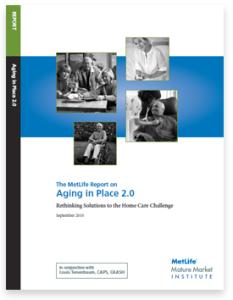
Author: Louis Tenenbaum, CAPS, CAASH
Publication Year:
Media Type: Report
Summary:
More than 35 million Americans are over 65, and that population is rising at an unprecedented rate. The MetLife Mature Market Institute recently responded to this shift with “The MetLife Report on Aging in Place 2.0: Rethinking Solutions to the Home Care Challenge.” The report serves as a “blueprint” for helping our growing population of older adults stay in their homes, or, “age in place”, through adjustments to residential design, health care, and other services.
Abstract:
As the percentage of our older population grows, more people need health care and assistance but there are fewer people to pay for it and perhaps not enough paid caregivers to deliver it. As an alternative to institutional care, “Aging in Place” means staying in one’s own home even when age- or health-related changes may make it difficult to do so. Although a large majority of older Americans say they want to Age in Place, it is often more easily said than done. Today’s care infrastructure, technologies, existing housing, funding sources, and the businesses and services available for Aging in Place are not being fully realized in order to achieve the promise most hope for as America ages.
A significant improvement to today’s current uncoordinated approach to Aging in Place can be achieved by focusing on the following three goals:
- Independence — happier, more satisfied older citizens living in homes of their choice with control, dignity, and respect
- More economical use of available resources
- The creation of a coordinated, comprehensive, and collaborative relationship between businesses and service providers to support Aging in Place.
While steps are being taken to make Aging in Place easier, the real challenge is answering “What strides are required for Aging in Place to reach its promise?”
As we age, health problems tend to be episodic, chronic, and sometimes progressive, resulting in an increasing need for assistance. Most “service-enriched” senior housing (nursing home, assisted living, independent living, and CCRC) is organized to provide care at a certain level of need, sometimes too much or too little for a particular individual. As a result, a housing arrangement often becomes a poor match, requiring residents to move multiple times, such as from a home to a hospital because of a health episode, then to a nursing home for rehabilitation, then back to the home, then on to assisted living for longer term care, etc. Moving between facilities is often disorienting, disturbing, and undesirable, not only for the individual but for the entire family.
The alternative to formal senior housing arrangements — aging in your own home with services — can also be very difficult because the services needed at different times and for different levels of care are not organized into an easily managed system. This report will explore a paradigm for a coordinated system that incorporates efficient use of available resources, technology integration, home adaptation, and care management models that can provide a framework to meet the needs of those who desire to Age in Place.
Arts & Intersections:
Categories: Aging
ADDITIONAL BIBLIOGRAPHICAL INFORMATION
PUBLISHER INFORMATION
Name: Metropolitan Life Insurance Company
Website URL: http://www.metlife.com